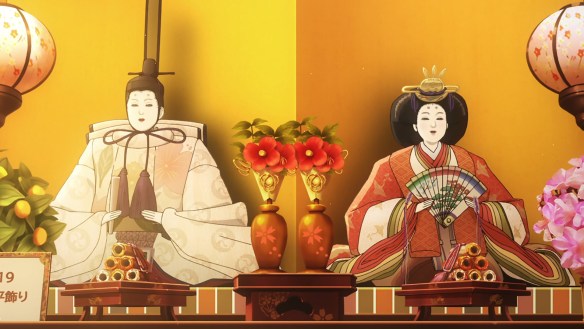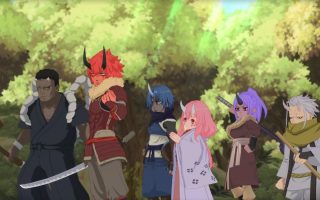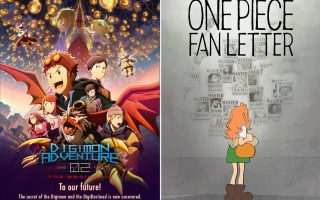Hello folks, and welcome back to Wrong Every Time. Today we’re checking out the first episode of a much-loved recent production, as we explore the premiere of My Dress-Up Darling. From what I understand, the story is a generally lighthearted romance centered on learning to proudly embrace your passions, as our cosplay enthusiast heroine draws her hina doll-crafting classmate out of his shell. As such, I’m expecting plenty of charming character moments, a healthy slice of adolescent social psychology, and perhaps even a closer look at the costume-making process.
As for our production team, it seems we’ve got a variety of younger figures in the key roles. Director Keisuke Shinohara has largely worked on individual episodes prior to this production, lending his talents to such distinguished productions as Bocchi the Rock!, Devilman Crybaby, and Flip Flappers. Character designer Kazumasa Ishida has also mostly worked as animation director on smaller projects, though the frequent overlaps in their resumes tells me they’ve clearly come to enjoy collaborating. This full-length production seems like a major break for both of them, so let’s see what the team has in store as we march into Dress-Up Darling!
Episode 1
“Someone Who Lives in the Exact Opposite World as Me.” Even our first episode title points towards the developmental stage and psychological preoccupations of our protagonists. It’s natural for a teenager to think in terms of his classmates living in “opposite worlds” – with the parameters of their world so harshly defined, social distance within the spheres of high school is everything. Of course, the truth is that most high schoolers working through the regular trials of adolescence actually have a tremendous amount in common, and are simply different degrees of psychologically paralyzed regarding earnestly engaging with and confiding in their fellow students. Kings and paupers live in opposite worlds – high schoolers, generally not so much
We open with a shot of our protagonist’s beloved hina dolls. These dolls are constructed for display on Hinamatsuri or “Girls’ Day,” wherein young girls are celebrated alongside their traditional dolls. Seems clear we’re going to get into the gendered expectations attendant in various hobbies – not only are hina dolls considered a “girl thing,” but their very format as a vision of the emperor and empress implies a reification of gender norms
As a young boy, our lead was dazzled by these dolls. I like the soft lines and variable line weight of these character designs
These dolls were made by his grandpa, meaning pursuing them is also pursuing a connection with his family history
Yeah, generally expressive faces and slight yet impactful character acting. A strong, economic aesthetic
Our lead’s childhood friend says she “hates him” for liking girlish things, and storms out. Well that would certainly lead him to hide his hobby!
And with that efficient flashback concluded, we jump to our lead as a teen, still having nightmares about that moment yet still enraptured by hina dolls. I particularly like the goofy, wobbly-lined smile he employs for his appreciation of hina dolls; it’s an awkward, inherently silly expression, emphasizing that we are all transparent and a little embarrassing when it comes to the things that inspire us
The OP further shows off this production’s emphasis on soft focus for highlighting specific aspects of the composition. A very gentle look in general for this show
Their hobbies seem to suit their affectations well; the creation of costumes is a diligent, solitary practice, while the active displaying of cosplay is all about bright social energy and being comfortable in your own skin
Our lead Wakana apparently still lives alone with his grandfather. No surprise he’s acclimated to a prematurely sedate, polite lifestyle
The OP also emphasized this generational divide, which does admittedly put more genuine distance between our two leads. Wakana lives in a simple house working with tools that haven’t changed for centuries, while our heroine is a fully digital girl who’s deeply attuned to modern youth culture
Even their breakfast is highly traditional
Wakana laments that he can’t get the faces right, only the clothes
“No need to hurry. Just keep at it.” His grandfather’s advice also emphasizes the constancy of their lives
Though he seems like a perfectly normal, agreeable guy, his preoccupation with dolls has apparently prevented him from reaching out and making any friends
“My bad! I thought you were someone else!” I like this beat that emphasizes his isolation through the awkwardness of one of his classmates. Nobody’s got it figured out here!
His hobby isolates him, while his classmates revel in how their shared interests pull them together. I suppose that will likely be a subtheme of the work going forward – that we don’t need to share precisely the same interests in order to find satisfaction and camaraderie in our friends’ passions
“What I like is so different from everyone else.” It’s funny, otaku interests themselves used to play this role in prior anime. Of course, anime is basically universally acknowledged youth culture at this point, and thus doesn’t really qualify as an “outsider interest” anymore. The only way you can isolate yourself through a love of anime these days is by being ostentatiously antisocial about it
“It’d be better if I just wasn’t here.” Pointed visual accompaniment here, as his wished-for disappearing act is made manifest through the billowing window curtain
And then the show literally flings our heroine at him. Hard to avoid a touch of that “antisocial guy enriched by dream girl” cliche feeling here, but it helps enormously that Wakana seems like a perfectly reasonable guy, one who’s simply undersocialized through a quirk of circumstance
Actually groaned out loud at the sound of her head hitting the desk. Great sound design, very painful!
Our heroine is Marin Kitagawa, who knows Wakana’s family name is Gojo. Remarkably fluid character acting as she flits around his desk, her exuberant personality conveyed largely through the bounciness of her movement
The observant Marin notices an ink smudge on his arm
The layouts do an excellent job of conveying Wakana’s simultaneous preoccupation with and desire to avert his eyes from Marin’s body
An anecdote from Marin’s friend reveals she gets hit on frequently, but is far more serious about her anime interests than romance. Unlike Wakana, she is proud of her passions and unafraid to hide them, seeing those who mock her for her interests as only telling on themselves. Pretty clear to see what Wakana has to learn from her
“He clearly knew it was from something I liked before he opened his mouth. You just don’t go making fun of things people clearly like.” A mature attitude for high school, where many people are willing to hide their passions for the sake of social approval
“She lives in a world where she’s accepted for who she is. It must be really comfortable in that world.” This reflection is accompanied by one of the most quintessential of all high school anime compositions: a profile shot of the lead in their back corner desk, the windows and wide open sky dominating the composition. A clear embodiment of caged yearning
Wakana isn’t exactly bullied by his classmates, but his failure to assert himself does lead to him getting taking advantage of
“This is way better than me failing at conversations and making things awkward.” A sad yet sympathetic instinct, essentially paying in favors for acquaintanceship because you don’t feel comfortable actually spending time with your peers
He’s actually a fairly sensitive guy, intuitively understanding that his silent presence would be a source of discomfort to his peers
Marin stops by to help clean up, and instantly clocks the weird dynamic between Gojo and his classmates
“You need to think about yourself more.” An attitude that comes naturally to Marin, but which Gojo has been studiously denying for years. If he can’t make friends with his classmates, he will at least avoid creating friction for them
“You need to speak up about how you’re feeling, for your own sake.” I appreciate that Marin immediately understands Gojo’s behavior as a mark not of kindness, but of cowardice
With his home sewing machine broken, Gojo is forced to bring his passion into the school’s craft department
Ooh, some very energetic storyboarding as Marin walks in on him talking to his doll. I like how the layouts are guided by the on-screen movement – first this doll flying to the left, and then Gojo slamming into the desks, all conveyed through wipe cuts that match the actual in-show movement
Marin is of course simply delighted that Gojo knows how to use a sewing machine
“This is the first time someone’s complimented something I love.”
Upon hearing he can make clothes, Marin immediately begins to undress. Unexpected, but I suppose it does fit into the general thematic framing of her as being willing to bare her honest self as compared to the cowering Gojo
The shoe is on the other foot as Marin shows off her feeble attempts at cosplay. In contrast with Marin’s practiced ability to validate the interests of others, Gojo can’t help but immediately declare she sucks at this. Even unintentionally, it is easy to hurt others where they are most fragile
His passion for critique immediately brings her to tears, but he’s self-aware enough to realize he went way too far. Extremely funny voice work as Gojo’s actor apologizes his way up into his naval cavity
“I made this because I wanted to cosplay!” She speaks proudly, declaring her intention for seemingly the first time, taking a brave step in her own right. The cinematography echoes her victory – she is framed illuminated by sunlight, practically embodying the world beyond the window that Gojo was previously craving
“It’s not in the best shape, and I don’t know anyone who’s good at sewing.” True friends don’t mock your for your passions, they help you realize the ambitions those passions spark in you
The character acting remains excellent; you can really appreciate the little leaps and falls in their confidence declaring their feelings
Thus Gojo agrees to make the outfit, just before learning Marin’s beloved character is from the “Slippery Girls” VN series
And Done
That was exceedingly charming! Our overall narrative beats hung pretty closely to the “dreary boy is drawn into the light by a brilliantly shining girl” template that has been a post-Haruhi staple, but the details are everything, and the particular execution of this narrative was excellent. Crucially, Gojo himself is a sympathetic loner who is naturally enjoyable to hang out with, while Marin feels like a genuine person who’s already demonstrating a variety of distinct layers to her personality. Additionally, the animation and storyboarding of this episode kept things lively and focused, with a particular emphasis on detailed character acting that made it easy to see these characters as they saw each other. I’m a sucker for an endearing romance, and this seems like a fine one indeed!
This article was made possible by reader support. Thank you all for all that you do.




